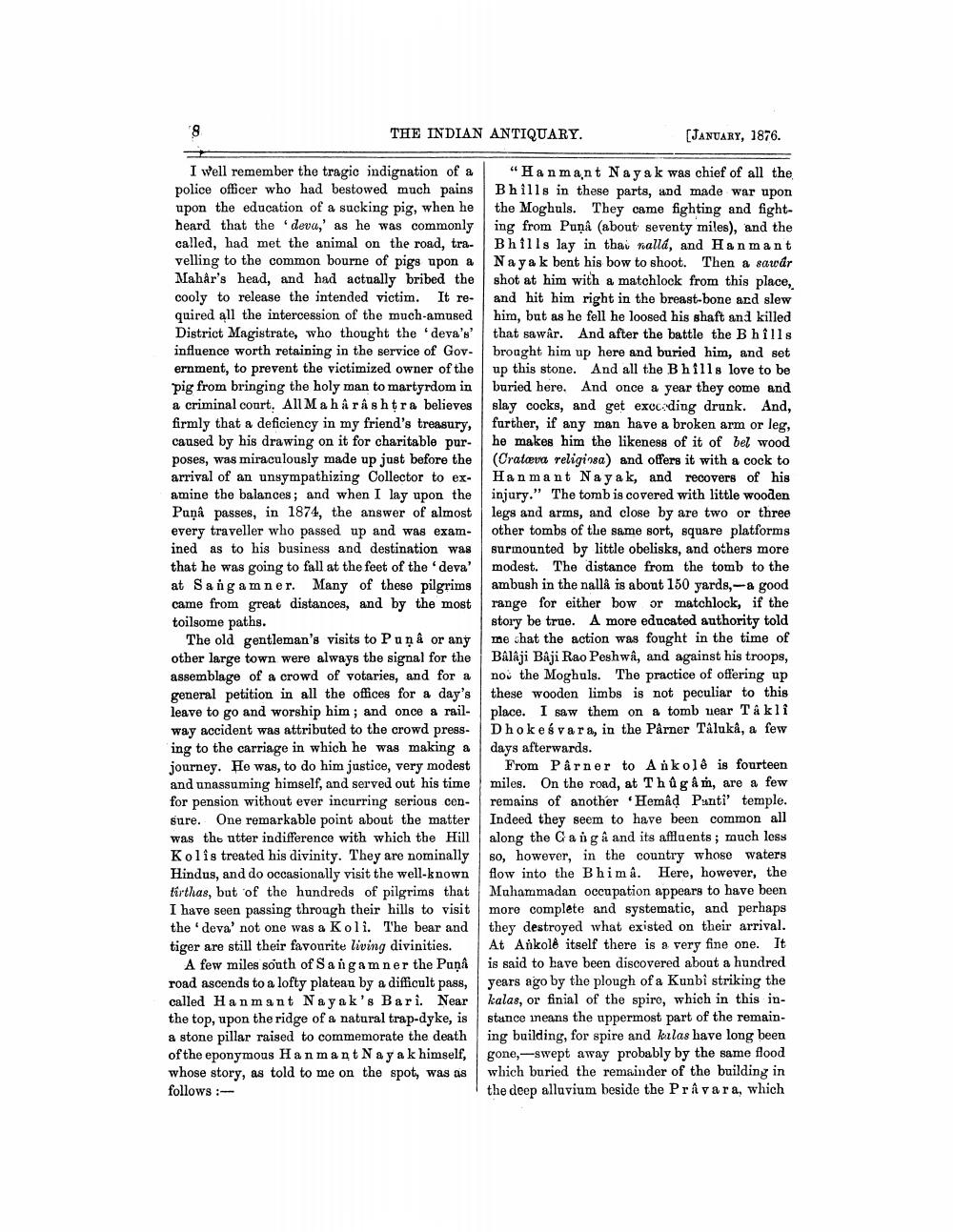________________
THE INDIAN ANTIQUARY.
[JANUARY, 1876.
I well remember the tragic indignation of a "Hanmant Nayak was chief of all the police officer who had bestowed much pains Bhills in these parts, and made war upon upon the education of a sucking pig, when he the Moghuls. They came fighting and fightheard that the deva,' as he was commonly ing from Puņa (about seventy miles), and the called, had met the animal on the road, tra- Bhills lay in thai nalla, and Hanmant velling to the common bourne of pigs upon a Nayak bent his bow to shoot. Then a sarar Mahar's head, and had actually bribed the shot at him with a matchlock from this place, cooly to release the intended victim. It re- and hit him right in the breast-bone ard slew quired all the intercession of the much-amused him, but as he fell he loosed his shaft and killed District Magistrate, who thought the deva's' that sawâr. And after the battle the Bhills influence worth retaining in the service of Gov. brought him up here and buried him, and set ernment, to prevent the victimized owner of the up this stone. And all the Bhills love to be pig from bringing the holy man to martyrdom in buried here. And once a year they come and a criminal court, All M a harashtra believes slay cooks, and get exceeding drunk. And, firmly that a deficiency in my friend's treasury, further, if any man have a broken arm or leg, caused by his drawing on it for charitable pur- he makes him the likeness of it of bel wood poses, was miraculously made up just before the (Cratæva religiosa) and offers it with a cock to arrival of an unsympathizing Collector to ex. Hanmant Nayak, and recovers of his amine the balances; and when I lay upon the injury." The tomb is covered with little wooden Paņa passes, in 1874, the answer of almost legs and arms, and close by are two or three every traveller who passed up and was exam. other tombs of the same sort, square platforms ined as to his business and destination was surmounted by little obelisks, and others more that he was going to fall at the feet of the 'deva' modest. The distance from the tomb to the at Sangamner. Many of these pilgrims ambush in the nallå is about 150 yards,-a good came from great distances, and by the most range for either bow or matchlock, if the toilsome paths.
story be true. A more educated authority told The old gentleman's visits to Puņå or any me chat the action was fought in the time of other large town were always the signal for the Balaji Baji Rao Peshwâ, and against his troops, assemblage of a crowd of votaries, and for a nou the Moghuls. The practice of offering up general petition in all the offices for a day's these wooden limbs is not peculiar to this leave to go and worship him; and once a rail. place. I saw them on a tomb near Takli way accident was attributed to the crowd press- Dhokes vara, in the Pårner Taluka, a few ing to the carriage in which he was making a days afterwards. journey. He was, to do him justice, very modest From Parner to Ankole is fourteen and unassuming himself, and served out his time miles. On the road, at Thagam, are a few for pension without ever incurring serious cen. remains of another Hemad Panti' temple. sure. One remarkable point about the matter Indeed they seem to have been common all was the utter indifference with which the Hill along the Ganga and its affluents; much less Kolîs treated his divinity. They are nominally so, however, in the country whose waters Hindus, and do occasionally visit the well-known flow into the Bhima. Here, however, the tarthas, but of the hundreds of pilgrims that Muhammadan occupation appears to have been I have seen passing through their hills to visit more complete and systematic, and perhaps the 'deva' not one was a Koli. The bear and they destroyed what existed on their arrival. tiger are still their favourite living divinities. At Ankole itself there is a very fine one. It
A few miles south of Sangamner the Puņa is said to have been discovered about a hundred road ascends to a lofty plateau by a difficult pass, years ago by the plough of a Kunbi striking the called Hanmant Nayak's Bari. Near kalas, or finial of the spire, which in this inthe top, upon the ridge of a natural trap-dyke, is stance ineans the uppermost part of the remaina stone pillar raised to commemorate the death ing building, for spire and loulas have long been of the eponymous Hanmant Nay a k himself, gone,--swept away probably by the same flood whose story, as told to me on the spot, was as which buried the remainder of the building in follows:
the deep alluvium beside the Privara, which




